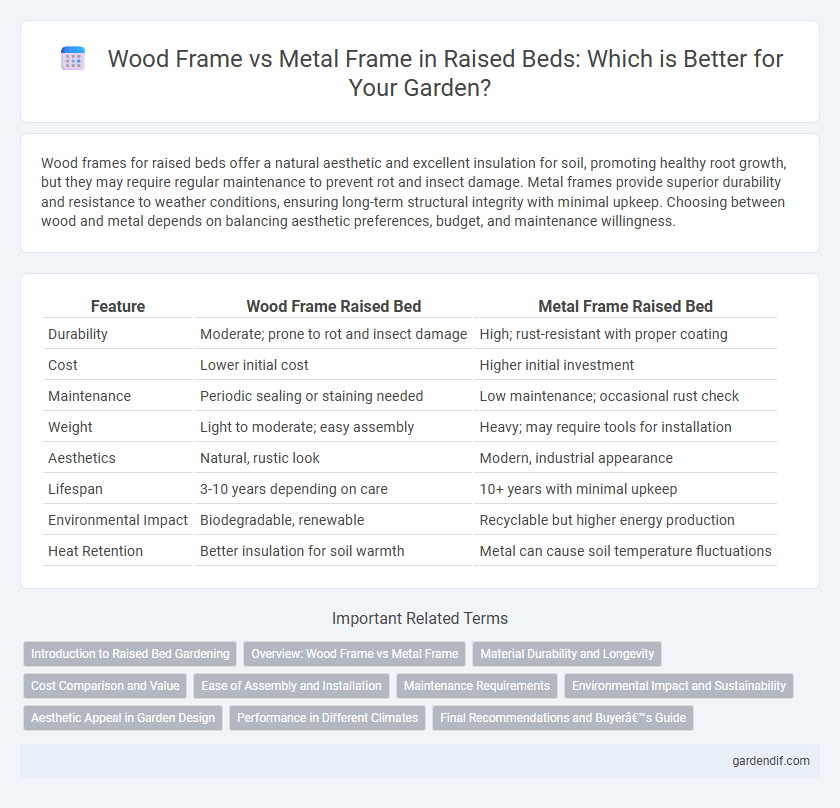
Wood frame vs Metal frame Illustration
Wood frames for raised beds offer a natural aesthetic and excellent insulation for soil, promoting healthy root growth, but they may require regular maintenance to prevent rot and insect damage. Metal frames provide superior durability and resistance to weather conditions, ensuring long-term structural integrity with minimal upkeep. Choosing between wood and metal depends on balancing aesthetic preferences, budget, and maintenance willingness.
Table of Comparison
| Feature | Wood Frame Raised Bed | Metal Frame Raised Bed |
|---|---|---|
| Durability | Moderate; prone to rot and insect damage | High; rust-resistant with proper coating |
| Cost | Lower initial cost | Higher initial investment |
| Maintenance | Periodic sealing or staining needed | Low maintenance; occasional rust check |
| Weight | Light to moderate; easy assembly | Heavy; may require tools for installation |
| Aesthetics | Natural, rustic look | Modern, industrial appearance |
| Lifespan | 3-10 years depending on care | 10+ years with minimal upkeep |
| Environmental Impact | Biodegradable, renewable | Recyclable but higher energy production |
| Heat Retention | Better insulation for soil warmth | Metal can cause soil temperature fluctuations |
Introduction to Raised Bed Gardening
Wood frames provide natural insulation and are easier to customize for raised bed gardening, while metal frames offer superior durability and resistance to pests and rot. Raised beds with wood frames often use cedar or redwood to avoid chemical leaching, whereas metal frames typically feature galvanized steel for rust protection. Choosing between wood and metal depends on budget, aesthetic preferences, and long-term maintenance considerations in raised bed gardening.
Overview: Wood Frame vs Metal Frame
Wood frames offer natural aesthetics and excellent insulation properties, making them ideal for maintaining soil warmth in raised beds. Metal frames provide superior durability, resistance to pests, and a sleek, modern appearance, often requiring less maintenance over time. Choosing between wood and metal raised bed frames depends on factors like climate, budget, and desired longevity.
Material Durability and Longevity
Wood frames for raised beds offer natural insulation and aesthetic appeal, but they are prone to rot, insect damage, and weathering, typically lasting between 5 to 10 years without treatment. Metal frames, often made from galvanized steel or aluminum, provide superior durability, resisting rust, corrosion, and structural warping, which can extend their lifespan to 20 years or more. Choosing metal frames ensures longer-lasting structural integrity with minimal maintenance compared to untreated or poorly maintained wooden frames.
Cost Comparison and Value
Wood frames for raised beds typically range from $30 to $100 depending on wood type and size, offering natural aesthetics and easier customization. Metal frames, usually priced between $50 and $150, provide superior durability and resistance to weather, reducing long-term replacement costs. Evaluating initial costs versus lifespan, metal frames deliver higher value for gardeners seeking longevity, while wood offers economical options with potential maintenance expenses.
Ease of Assembly and Installation
Wood frames for raised beds offer straightforward assembly due to their lightweight nature and the availability of pre-cut kits, making it easy for beginners to handle with basic tools. Metal frames, while more durable, often require additional hardware and tools like screws or rivets, which can increase installation time and complexity. Choosing wood frames can significantly reduce setup effort, especially for gardeners seeking quick, hassle-free installation.
Maintenance Requirements
Wood frames for raised beds require regular maintenance such as sealing, staining, or painting to prevent rot, insect damage, and warping, especially in humid or wet climates. Metal frames offer superior durability with minimal upkeep, resisting rust and corrosion when treated or made from galvanised steel or aluminum. Choosing metal over wood significantly reduces long-term maintenance efforts and replacement costs in garden bed construction.
Environmental Impact and Sustainability
Wood frames for raised beds often offer greater environmental benefits due to their renewable nature and ability to sequester carbon, especially when sourced from sustainably managed forests. Metal frames, while durable and recyclable, typically involve higher energy consumption and carbon emissions during production, impacting their overall sustainability. Choosing untreated, natural wood reduces chemical runoff and soil contamination, enhancing eco-friendliness in garden setups.
Aesthetic Appeal in Garden Design
Wood frames offer a natural, warm aesthetic that blends seamlessly with most garden styles, enhancing the organic feel of outdoor spaces. Metal frames provide a sleek, modern look with clean lines and durability, making them ideal for contemporary garden designs. Choosing between wood and metal frames depends on the desired visual impact and the overall theme of the garden.
Performance in Different Climates
Wood frames offer superior insulation and natural breathability, making them ideal for temperate and dry climates by maintaining soil temperature and moisture levels effectively. Metal frames provide exceptional durability and resistance to pests and rot, performing well in humid and wet environments but may require additional insulation to prevent soil temperature fluctuations. In regions with extreme temperatures, combining materials or adding protective coatings enhances longevity and plant growth consistency.
Final Recommendations and Buyer’s Guide
Choose a wood frame for raised beds when prioritizing natural aesthetics, ease of customization, and cost-effectiveness, especially using rot-resistant woods like cedar or redwood for durability. Opt for metal frames when seeking superior longevity, high resistance to pests and weather, and a modern industrial look, with galvanized steel as a popular rust-resistant option. For buyers, consider climate, maintenance willingness, and budget, ensuring wood is treated against decay or metal is coated to prevent corrosion for optimal performance.
Wood frame vs Metal frame Infographic

 gardendif.com
gardendif.com